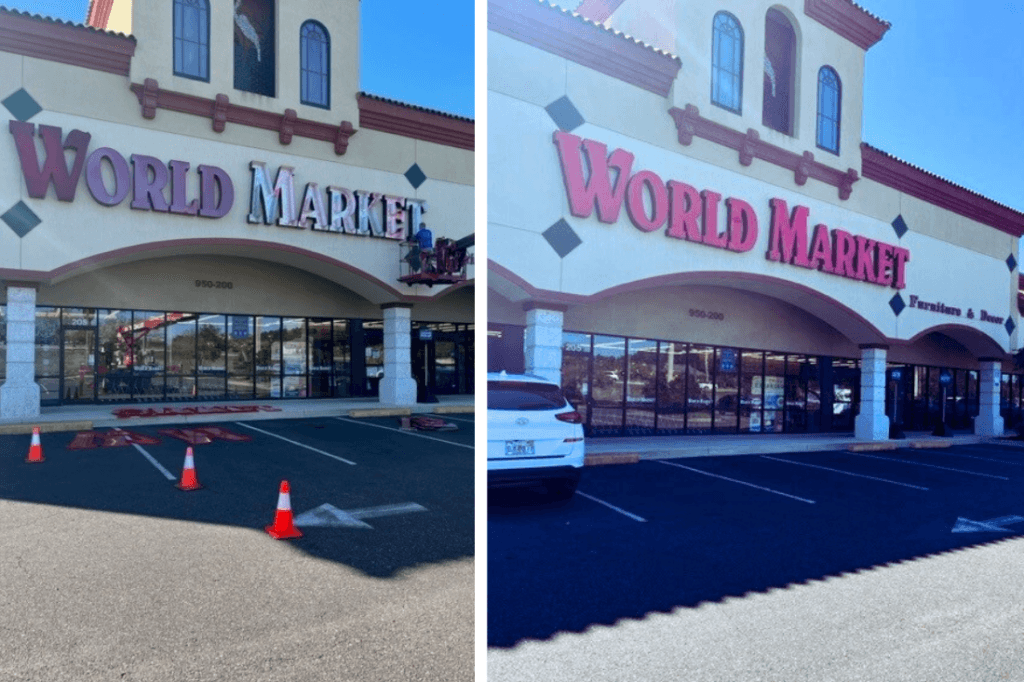
Deteriorating Signs? Do you Refurbish or Replace Them?
Your business’s exterior sign is more than just a marker; it’s a visual handshake, a first impression that can significantly influence customer perceptions. As the initial point of contact between a business and its clientele, your sign is your constant brand ambassador, working 24/7 to promote your business, making it one of your most valuable assets.
THE AGING DILEMMA
As signs weather the storms and endure the passing of time, they can begin to lose their luster. Fading colors, damaged frames, warped structures, cracked surfaces, lighting outages, dirt/mildew buildup and peeling paint are all signs of wear and tear. The question then arises: should you replace the aging sign entirely or opt for a more economical refurbishment?
REPLACE: A FRESH START
For businesses with a healthy budget and a long-term vision, the decision to replace signage may be a straightforward one. Investing in brand-new signage ensures a fresh, eye-catching appearance that aligns with the latest design trends. If money is not a limiting factor and you foresee a sustained presence in the market, replacing your signage can be a strategic move.
The benefits of replacement include:
1. Enhanced Visibility: Fresh signage can stand out more effectively, grabbing the attention of potential customers.
2. Improved Lighting: If your sign is older, replacing it would give you the opportunity to update the older lighting with brighter energy-efficient options.
3. Protected Investment: Most companies provide a warranty on new signs, protecting your investment for a pre-determined length of time should something go wrong.
REFURBISH: A COST-EFFECTIVE SOLUTION
On the other hand, refurbishing your existing signage offers a more economical alternative. This option involves revitalizing the various components of your sign, such as faces, poles, cabinets, internal illumination, and other elements that may be showing signs of deterioration. Read our client case study here.
Consider the advantages of refurbishment:
1. Cost Savings: Refurbishing is often more budget-friendly than a complete replacement, making it an attractive option for businesses with financial constraints.
2. Customization: Refurbishment allows for customization, enabling you to update specific elements, such as replacing fluorescent lighting with LEDS, while retaining the overall structure of your sign.
3. Sustainability: Choosing to refurbish aligns with sustainability goals by extending the lifespan of existing materials and reducing waste.
4. Reduced Business Disruption: The lead time for completely new signage can be lengthy. The removal and installation process can temporarily disrupt customer access and your brand image. A refurbishment is much faster, with little to no downtime.
MAKING THE RIGHT CHOICE
Ultimately, the decision to refurbish or replace your signage depends on several factors, including budget considerations and your long-term business plans. If you are leasing your property and anticipate not being in the location for an extended period, opting to refurbish the sign instead of investing in a replacement would make more sense.
One thing to not overlook is the size of your sign, particularly for pylons and monument signs. If replacing an existing sign, be aware that sign codes may have changed, impacting the allowable size. If your sign is grandfathered, refurbishing it is the optimal choice if you want to maintain the same size.
If you find yourself at the crossroads of this signage dilemma, carefully weigh the pros and cons of each option. If properly managed, a sign refurbishing project can be implemented quickly, minimizing business disruption.
Whether you replace or refurbish, the primary goal is to maintain a captivating and professional image that resonates with your target audience. In business, securing every advantage is crucial. Your sign is undoubtedly the first thing people view, so keeping it looking its best could be the determining factor in making an impression that draws people in or the catalyst for falling flat.
